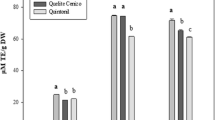Abstract
Pulses are valued for their protein content and are good source of bioactive phytochemicals. The objectives of this study were to estimate total phenolic content (TPC), flavonoid content and total antioxidant capacity (TAC) through six different assay methods from twenty seven different varieties of pulses and split pulses commonly consumed in India. TPC and flavonoid content ranged between 38.6–542.7 mg GAE/100 g and 18.3–344.7 mg RE/100 g respectively. TAC measured by FRAP (90.6–2773.5 mg TE/100 g), RPA (190.8–2128.4 mg TE/100 g), DPPH radical scavenging assay (RSA) (42.9–571.1 mg TE/100 g), ABTS RSA (4.5–194.9 mg TE/100 g), hydroxyl RSA (0.0–106.6 mg AAE/g) and nitric oxide (NO) RSA (11.9–43.7 mg AAE/100 g) varied widely among pulses and split pulses analysed in the present study. TAC measured using different methods showed positively strong and significant correlation with TPC as well as flavonoid content except NORSA, indicating that phenolic compounds are the major contributors to the antioxidant properties of these plants. Food composition data obtained in this study would enrich the composition database at global level, which in turn will guide in improving food and nutrition security of the population. These can be used for further research, diet formulation and epidemiological studies. From the results it can be concluded that cow pea (red, small) had the highest TPC and TAC measured by all the parameters except NORSA.


Similar content being viewed by others
References
Benzie IF, Strain JJ (1999) Ferric reducing/antioxidant power assay: direct measure of total antioxidant activity of biological fluids and modified version for simultaneous measurement of total antioxidant power and ascorbic acid concentration. Methods Enzymol 299:15–27
Brand-Williams W, Cuvelier ME, Berset C (1995) Use of a free radical method to evaluate antioxidant activity. LWT Food Sci Technol 28:25–30
Duenas M, Hernandez T, Estrella I (2006) Assessment of in vitro antioxidant capacity of the seed coat and the cotyledon of legumes in relation to their phenolic contents. Food Chem 98:95–103
Dueñas M, Sun B, Hernández T, Estrella I, Spranger MI (2003) Proanthocyanidin composition in the seed coat of lentils (Lens culinaris L.). J Agric Food Chem 51:7999–8004
Duh PD (1998) Antioxidant activity of burdock (Arctium lappa Linne): its scavenging effect on free-radical and active oxygen. J Am Oil Chem Soc 75:455–461
FAOSTAT (2014) Food and agric. Organization of the United Nations, Rome, Italy, Food Outlook Biannual report on global food markets May 2014. http://www.fao.org/documents/3/a-I5703E.pdf. Assessed 9 Dec 2016
Gordon JR, Galli SJ (1990) Mast cells as a source of both preformed and immunologically inducible TNF-α/cachectin. Nature 346:274–276
Gujral HS, Sharma P, Gupta N, Wani AA (2013) Antioxidant properties of legumes and their morphological fractions as affected by cooking. Food Sci Biotechnol 22:187–194
Jayaprakasha GK, Patil BS (2007) In vitro evaluation of the antioxidant activities in fruit extracts form citron and blood orange. Food Chem 101:410–418
Jin M, Cai YX, Li JR, Zhao H (1996) 1,10-Phenanthroline-Fe2+ oxidative assay of hydroxyl radical produced by H2O2/Fe2+. Prog Biochem Biophys 23:553–555
Kabagambe EK, Baylin A, Ruiz-Narvarez E (2005) Decreased consumption of dried mature beans is positively associated with urbanization and non fatal acute myocardial infarction. J Nutr 135:1770–1775
Lata H, Ahuja GK (2003) Ind J Physio Allied Sci 57:124. In Singhal M, Paul A, Singh HP (2011) Nitric oxide scavenging activity of synthesized methyl semicarbazone derivatives. Der Pharma Chem 3:460–467
Lee J, Koo N, Min DB (2004) Reactive oxygen species, aging, and antioxidative nutraceuticals. Compr Rev Food Sci Food Saf 3:21–33
Li Y, Jiang B, Zhang T, Mu W, Liu J (2008) Antioxidant and free radical-scavenging activities of chickpea protein hydrolysate (CPH). Food Chem 106:444–450
Marathe SA, Rajalakshmi V, Jamdar SN, Sharma A (2011) Comparative study on antioxidant activity of different varieties of commonly consumed legumes in India. Food Chem Toxicol 49:2005–2012
Marcocci L, Maguire JJ, Droylefaix MT, Packer L (1994) The nitric oxide-scavenging properties of Ginkgo biloba extract EGb 761. Biochem Biophys Res Comm 201:748–755
Nilsson J, Stegmark R, Åkesson B (2004) Total antioxidant capacity in different pea (Pisum sativum) varieties after blanching and freezing. Food Chem 86:501–507
Oyaizu M (1986) Studies on products of browning reactions: antioxidative activities of products of browning reaction prepared from glucosamine. Jpn J Nutr 44:307–315
Parikh B, Patel VH (2016) Quantification of phenolic compounds and antioxidant capacity of an underutilized Indian fruit: Rayan [Manilkara hexandra (Roxb. Dubard]. Food Sci Hum Wellness. https://doi.org/10.1016/j.fshw.2016.11.002
Prakash D, Upadhyay G, Singh BN, Singh HB (2007) Antioxidant and free radical-scavenging activities of seeds and agri-wastes of some varieties of soybean (Glycine max). Food Chem 104:783–790
Re R, Pellegrini N, Proteggente A, Pannala A, Yang M, Rice-Evans CA (1999) Antioxidant activity applying an improved ABTS radical cation decolorization assay. Free Rad Biol Med 26:1231–1237
Russo A, Cardile V, Lombardo L, Vanella L, Acquaviva R (2006) Genistin inhibits UV light-induced plasmid DNA damage and cell growth in human melanoma cells. J Nutr Biochem 17:103–108
Sethi S, Samuel DVK, Khan I (2014) Development and quality evaluation of quick cooking dhal—a convenience product. J Food Sci Technol 51:595–600
Siddhuraju P (2006) The antioxidant activity and free radical-scavenging capacity of phenolics of raw and dry heated moth bean (Vigna aconitifolia) (Jacq.) Marechal seed extracts. Food Chem 99:149–157
Singh B, Singh JP, Shevkani K, Singh N, Kaur A (2016a) Bioactive constituents in pulses and their health benefits. J Food Sci Technol. https://doi.org/10.1007/s13197-016-2391-9
Singh JP, Kaur A, Shevkani K, Singh N (2016b) Composition, bioactive compounds and antioxidant activity of common Indian fruits and vegetables. J Food Sci Technol 53:4056–4066
Singleton VL, Orthofer R, Lamuela-Raventos RM (1999) Analysis of total phenols and other oxidation substrates and antioxidants by means of Folin–Ciocalteu reagent. Methods Enzymol 299:152–178
Sreejayan N, Rao MNA (1997) J Pharm Pharnacol 49:105–109. In Singhal M, Paul A, Singh HP (2011) Nitric oxide scavenging activity of synthesized methyl semicarbazone derivatives. Der Pharma Chem 3:460–467
Sreeramulu D, Reddy CVK, Raghunath M (2009) Antioxidant activity of commonly consumed cereals, millets, pulses and legumes in India. Indian J Biochem Biophys 46:112–115
Sreeramulu D, Reddy CVK, Chauhan A, Balakrishna N, Raghunath M (2013) Natural antioxidant activity of commonly consumed plant foods in India: effect of domestic processing. Oxid Med Cell Longev. https://doi.org/10.1155/2013/369479
Yen GC, Hsieh PP (1995) Antioxidative activity and scavenging effects on active oxygen of xylose-lysine maillard reaction products. J Sci Food Agric 67:415–420
Yeo J, Shahidi F (2015) A critical evaluation of changes in the ratio of insoluble-bound to soluble phenolics on antioxidant activity of lentils during germination. J Agric Food Chem 63:379–381
Zhishen J, Mengcheng T, Jianming W (1999) The determination of flavonoid contents in mulberry and their scavenging effects on superoxide radicals. Food Chem 64:555–559
Acknowledgements
We are thankful to the University Grant Commission (UGC), New Delhi, India for financial support under Major Research Project (F. No. 39-96/2010) and for award of UGC BSR fellowship to the first author (Office order No. C/2013/8012).
Author information
Authors and Affiliations
Corresponding author
Electronic supplementary material
Below is the link to the electronic supplementary material.
Rights and permissions
About this article
Cite this article
Parikh, B., Patel, V.H. Total phenolic content and total antioxidant capacity of common Indian pulses and split pulses. J Food Sci Technol 55, 1499–1507 (2018). https://doi.org/10.1007/s13197-018-3066-5
Revised:
Accepted:
Published:
Issue Date:
DOI: https://doi.org/10.1007/s13197-018-3066-5




